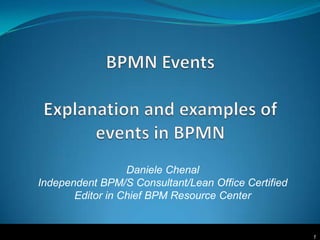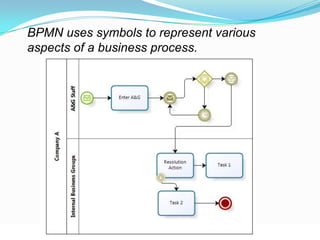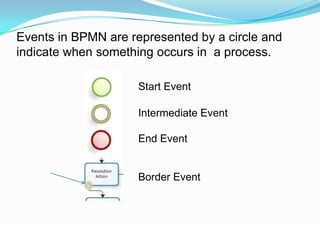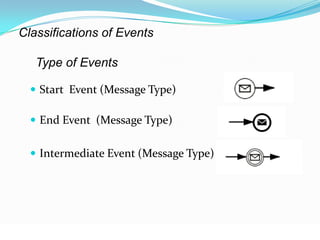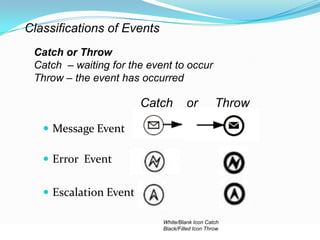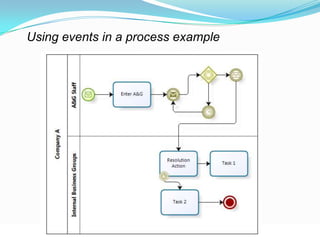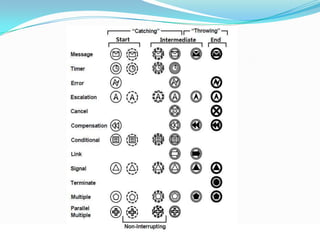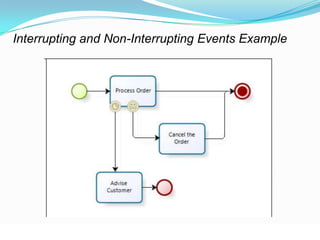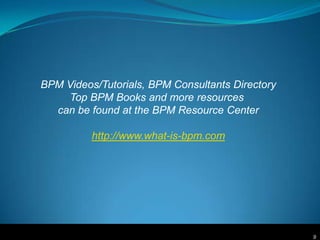Examples of bpmn events
- 1. Daniele Chenal Independent BPM/S Consultant/Lean Office Certified Editor in Chief BPM Resource Center 1
- 2. BPMN uses symbols to represent various aspects of a business process.
- 3. Events in BPMN are represented by a circle and indicate when something occurs in a process. Start Event Intermediate Event End Event Border Event
- 4. Classifications of Events Type of Events ï Start Event (Message Type) ï End Event (Message Type) ï Intermediate Event (Message Type)
- 5. Classifications of Events Catch or Throw Catch â waiting for the event to occur Throw â the event has occurred Catch or Throw ï Message Event ï Error Event ï Escalation Event White/Blank Icon Catch Black/Filled Icon Throw
- 6. Using events in a process example
- 8. Interrupting and Non-Interrupting Events Example
- 9. BPM Videos/Tutorials, BPM Consultants Directory Top BPM Books and more resources can be found at the BPM Resource Center http://www.what-is-bpm.com 9
Editor's Notes
- BPMN events are represented as circles and indicate when some event occurs (as opposed to activities which are when some task is performed). Events can occur at the beginning of the process called Start events â and every process starts with a circle. Events occur at the end of the process called end events and every process has at least one end event or events can occur in the middle of the process (between activities) called an intermediate event.Events can also occur during an activity. This is known as a border event. For example you may be assigned a task with a deadline. The deadline would be shown as a time event on the activity.
- Also within the circle, there will be an icon which indicates the type of event. For example â a circle with an envelope indicates a message event occurred and this event will start the process â this could be the receipt of an email.
- Events also have an attribute of catch or throw. This is indicated by the icon being solid or empty. A message catch event would be an event âwaitingâ for a message to arrive and a throw message event would actually send the message out.
- The first event is a start event (message catch). Upon receipt (catch) of an email an instance of this process is started. Next an activity occurs to enter an A&G. Once done, an intermediate event (message throw) occurs. This event sends a email out. The process is now waiting for one of two possible events to occur. The path down from the gateway is an intermediate event (timer catch). The process will wait a specified period of time â if the timer expires the process sends another email. If on the other hand a message is received back express by the intermediate event (message catch) then the process will continue.Assume we receive the message, the process flows to the resolution action. This action has a border event (time catch). So if the deadline expires the task will flow to task 2.
- This shows all of the different types of events and the classifications. Youâll notice some events do not have all states. Another thing you notice is some events have dotted lines. These represent the concept of interrupting and non-interrupting events. Meaning that when the event occurs it will or will not interrupt the default flow of the process based on if it is an interrupting on non interrupting event.If this seems overwhelming, donât panic. If you are modeling BPMN models for business use and do not intend to implement them in an execution engine you do not need to focus on the events found in the 2.0 version of the BPMN notation as these are very specific to execution engines.
- In this example, the border event (timer catch non-interrupting) on the Process Order activity when triggered would create a new activity to Advise the Customer, however the Process Order activity would remain active. However, if the border event (message catch interrupting) event occurs then the Process Order activity would no longer be active and the process would flow to and create the Cancel the Order activity.

